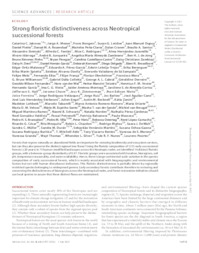Strong floristic distinctiveness across Neotropical successional forests.
Strong floristic distinctiveness across Neotropical successional forests.
Autoria: JAKOVAC, C. C.; MEAVE, J. A.; BONGERS, F.; LETCHER, S. G.; DUPUY, J. M.; PIOTTO, D.; ROZENDAAL, D. M. A.; PEÑA-CLAROS, M.; CRAVEN, D.; SANTOS, B. A.; SIMINSKI, A.; FANTINI, A. C.; RODRIGUES, A. C.; HERNÁNDEZ-JARAMILLO, A.; IDÁRRAGA, A.; JUNQUEIRA, A. B.; ZAMBRANO, A. M. A.; JONG, B. H. J. de; PINHO, B. X.; FINEGAN, B.; CASTELLANO-CASTRO, C.; ZAMBIAZI, D. C.; DENT, D. H.; GARCÍA, D. H.; KENNARD, D.; DELGADO, D.; BROADBENT, E. N.; ORTIZ-MALAVASSI, E.; PÉREZ-GARCÍA, E. A.; LEBRIJA-TREJOS, E.; BERENGUER, E.; MARÍN-SPIOTTA, E.; ALVAREZ-DAVILA, E.; SAMPAIO, E. V. de S.; MELO, F.; ELIAS, F.; FRANÇA, F.; OBERLEITNER, F.; MORA, F.; WILLIAMSON, G. B.; COLLETTA, G. D.; CABRAL, G. A. L.; DERROIRE, G.; FERNANDES, G. W.; WAL, H. van der; TEIXEIRA, H. M.; VESTER, H. F. M.; GARCÍA, H.; VIEIRA, I. C. G.; JIMÉNEZ-MONTOYA, J.; ALMEIDA-CORTEZ, J. S. de; HALL, J. S.; CHAVE, J.; ZIMMERMAN, J. K.; EDISON NIETO, J.; FERREIRA, J. N.; RODRÍGUEZ-VELÁZQUEZ, J.; RUÍZ, J.; BARLOW, J.; AGUILAR-CANO, J.; HERNÁNDEZ-STEFANONI, J. L.; ENGEL, J.; BECKNELL, J. M.; ZANINI, K.; LOHBECK, M.; TABARELLI, M.; ROMERO-ROMERO, M. A.; URIARTE, M.; VELOSO, M. D. M.; ESPÍRITO-SANTO, M. M.; SANDE, M. T. van der; BREUGEL, M. van; MARTÍNEZ-RAMOS, M.; SCHWARTZ, N. B.; NORDEN, N.; PÉREZ-CÁRDENAS, N.; GONZÁLEZ-VALDIVIA, N.; PETRONELLI, P.; BALVANERA, P.; MASSOCA, P.; BRANCALION, P. H. S.; VILLA, P. M.; HIETZ, P.; OSTERTAG, R.; LÓPEZ-CAMACHO, R.; CÉSAR, R. G.; MESQUITA, R.; CHAZDON, R. L.; MUÑOZ, R.; DeWALT, S. J.; MÜLLER, S. C.; DURÁN, S. M.; MARTINS, S. V.; OCHOA-GAONA, S.; RODRÍGUEZ-BURITICA, S.; AIDE, T. M.; BENTOS, T. V.; MORENO, V. de S.; GRANDA, V.; THOMAS, W.; SILVER, W. L.; NUNES, Y. R. F.; POORTER, L.
Resumo: Forests that regrow naturally on abandoned fields are important for restoring biodiversity and ecosystem services, but can they also preserve the distinct regional tree floras? Using the floristic composition of 1215 early successional forests (<20 years) in 75 human-modified landscapes across the Neotropic realm, we identified 14 distinct floristic groups, with a between-group dissimilarity of 0.97. Floristic groups were associated with location, bioregions, soil pH, temperature seasonality, and water availability. Hence, there is large continental-scale variation in the species composition of early successional forests, which is mainly associated with biogeographic and environmental factors but not with human disturbance indicators. This floristic distinctiveness is partially driven by regionally restricted species belonging to widespread genera. Early secondary forests contribute therefore to restoring and conserving the distinctiveness of bioregions across the Neotropical realm, and forest restoration initiatives should use local species to assure that these distinct floras are maintained.
Ano de publicação: 2022
Tipo de publicação: Artigo de periódico
Unidade: Embrapa Amazônia Oriental
Palavras-chave: Biodiversidade, Floresta, Preservação da Natureza
Observações
1 - Por padrão são exibidas publicações dos últimos 20 anos. Para encontrar publicações mais antigas, configure o filtro ano de publicação, colocando o ano a partir do qual você deseja encontrar publicações. O filtro está na coluna da esquerda na busca acima.
2 - Para ler algumas publicações da Embrapa (apenas as que estão em formato ePub), é necessário ter, no celular ou computador, um desses softwares gratuitos. Sistemas Android: Google Play Livros; IOS: iBooks; Windows e Linux: software Calibre.
Acesse outras publicações
Acesse a Base de Dados da Pesquisa Agropecuária (BDPA) para consultar o acervo completo das bibliotecas da Embrapa.

